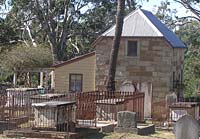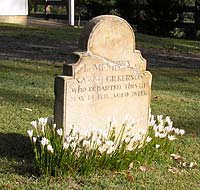
Historic Ebenezer Church - since 1809
Visit Ebenezer Church & Shop
Ebenezer Church
The church is open each day for visitors who are welcome to take a self-guided tour pamphlet from the porch. The pamphlet contains information on the historic precinct of the church, the cemetery, the churchyard and the historic tree across Coromandel Road.
Your tour should include a visit to the Schoolmaster’s House which contains photographs and memorabilia on the church’s interesting history.
The Schoolmaster's House
Phone: (02) 4579 9350  This two-storey sandstone building was constructed in 1817 as a residence for the teacher, school being conducted in the church.
This two-storey sandstone building was constructed in 1817 as a residence for the teacher, school being conducted in the church.
Volunteers keep the shop in the Schoolmaster’s House open Wednesday to Sunday, except for Good Friday and a few days near Christmas.
Casual visitors may enjoy devonshire teas and purchase locally made jams, craft, souvenirs and family and church history books.
Books of particular interest to visitors are ‘The History of Ebenezer, Australia’s Oldest Church’ and ‘A Colonial Churchyard’.
Inside the Schoolmaster’s House are displays of old photographs and memorabilia.
The Schoolmaster’s House is open daily from 10.00am to 3.00pm, often closing later at weekends. Devonshire teas/coffees (but not lunches) are available for casual visitors.
 Larger groups of people such as coach groups, car clubs or social groups need to make bookings for teas or lunches. A talk on the fascinating history of Ebenezer Church is offered at no extra charge.
Larger groups of people such as coach groups, car clubs or social groups need to make bookings for teas or lunches. A talk on the fascinating history of Ebenezer Church is offered at no extra charge.
You can make a booking by ringing the Church Shop on 02 4579 9350 or inquiring by email to .
Coaches may make casual visits to the church though some notification by ringing Ebenezer Church on (02) 4579 9350 would be appreciated.
Ebenezer Church Cemetery
Ebenezer Church and its community have a unique place in the heritage of Christian faith and in pioneer farming of the nation. The cemetery in the churchyard is recognised as historically being one of the most important cemeteries in Australia.
It was the first Presbyterian cemetery and contains the graves of many of the Scots who arrived on the ship the ‘Coromandel’ in 1802 and other church pioneers who were amongst the first settlers in the Hawkesbury.
Only two and a half years after settlement at Portland Head, William Stubbs, a Coromandel settler, drowned in the river, his burial taking place on the family grant at Swallow Rock Reach. No doubt this sad incident made the pioneers aware of the need for a common burial place.
It is difficult to determine accurately when the churchyard was first used as a cemetery as early church records were lost in the 1867 flood. However the oldest grave appears to be that of Sarah Gilkerson. The inscription on a single sandstone headstone reads:
In Memory of
SARAH GILKERSON
who departed this life
May 14 1813 Aged 3 weeks.
 The cemetery contains gravestones from 1813 and through the 1820’s, that is, simple sandstone headstones with footstones. It also includes graves from the Victorian period, a period when the austere Scots permitted a small amount of decoration and simple iron surrounds. Many of the iron guards are still intact and recent efforts have been made to preserve them. There are also graves from the early and late twentieth century and up to the present day.
The cemetery contains gravestones from 1813 and through the 1820’s, that is, simple sandstone headstones with footstones. It also includes graves from the Victorian period, a period when the austere Scots permitted a small amount of decoration and simple iron surrounds. Many of the iron guards are still intact and recent efforts have been made to preserve them. There are also graves from the early and late twentieth century and up to the present day.